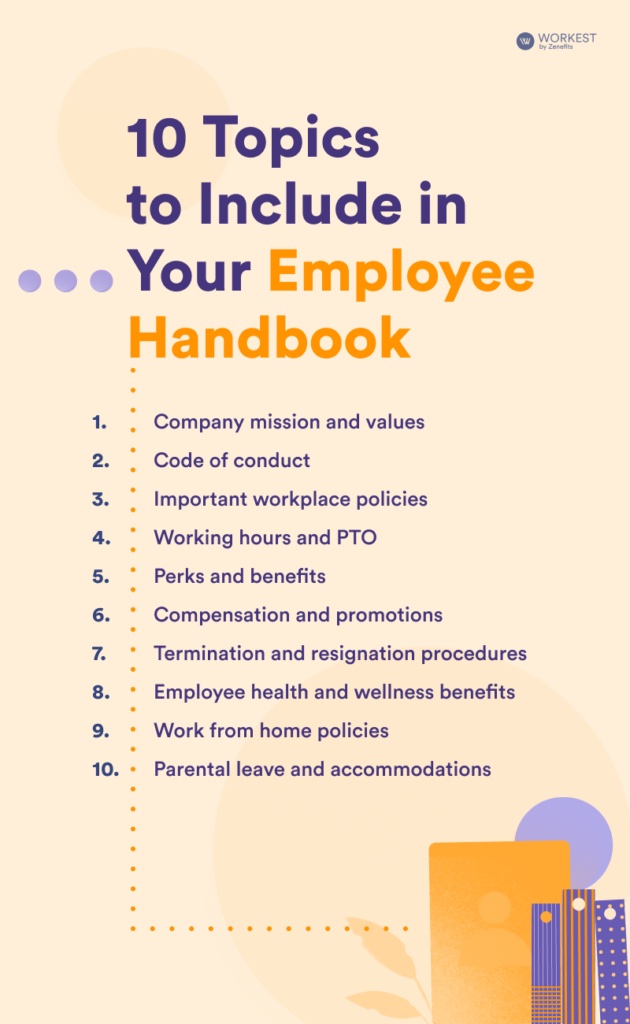The employee handbook relays essential details about workplace guidelines. It helps express the company’s vision and provides employees with the resources to do their jobs well. Creating a handbook can be a daunting task. Even established businesses will benefit from amending handbook information now and then. Employee handbooks set foundational expectations for employees. They reduce uncertainty and open the floor for any follow-up questions. Circumstances change, however, and there may be some sections that require a redo. With the turn of the new year, it could be time to look at applying relevant changes to your employee handbook.

What should you include in an employee handbook?
Every employee handbook should clearly identify procedures necessary for an efficient work environment. The bottom line should be apparent during the discussion of standard topics, including:
Company mission and values
The company handbook is the perfect place to set the stage for the company’s thorough introduction. This should include the business background, founders, culture, and values. Company mission statements help remind employees of how critical each of their roles are to the business. A letter from leadership personally expressing their gratitude for employees can solidify this.
Code of conduct
The code of conduct is the framework for employee ethics. It’s essentially what outlines the expectations for employee behavior as it pertains to:
- Dress code
- Visitors
- Fraternization
- Internet usage
- Political posters
- Receiving gifts
Each piece of the code of conduct should lay out the appropriate behaviors sought out by employers. They should also include possible disciplinary actions if ethical standards aren’t adhered to. This helps minimize surprises and keeps employees in sync with businesslike appearances.
Important workplace policies
Some policies may be more in-depth and would deserve their place in a separate policy handbook instead. However, specific workplace policies may need a disclosure in the employee handbook. No-tolerance policies could include anti-harassment and workplace safety procedures. These need upfront disclosures. Policies like these come with legal requirements used to protect employees and businesses. It could be beneficial for attorneys to look over important information like this to ensure legal compliance.
Working hours and PTO
The expected working hours of an employee are details that get handled during the interview process. Nevertheless, it matters to have all the working hours and leave details in an employee handbook. Some companies have several types of leave, and there could be strict guidelines for their usage. Employees should know the difference between:
- Holiday leave
- Sick leave
- Bereavement leave
- Military leave
- Child education leave
- Jury duty
- Family medical leave
- Maternity/paternity leave
- Vacation
- And more
Seeing a list like this may be overwhelming for new hires during the
employee onboarding process. They need to know the appropriate times to take these leaves and the procedure for requesting them. Employers can lay out any exceptions to avoid any confusion and unexcused absences.
Perks and benefits
Benefits packages potentially change every few years or so. This will require regular updates to an employee handbook. However, a general layout of all employee benefits, retirement, and insurance information is a must.
There should still be standalone documentation detailing the ins and outs of each benefit.
There should still be standalone documentation detailing the ins and outs of each benefit. This could include resources, insurance applications, and application processes. This way, employers can spend less time with yearly handbook updates. Plus, employees can always have access to the right information.
Compensation and promotions
An employee’s pay is another detail that requires head-on disclosure. After an employee knows how much of a living they’ll make, they’ll want to know what it takes to get a raise. So, an employee handbook should include important information about professional development. Employees can always reference this section as they try to optimize their performance. They will know about their chain of command and be aware of all the steps necessary to increase their earnings.
Termination and resignation procedures
Many different violations could lead to termination. It helps to tell employees what this process generally looks like. Whatever the reason for separation, clear offboarding process documentation can clear the air of any confusion or conflicts. Essentially, this section helps employees avoid these situations by knowing what not to do.
Areas for improving your employee handbook in 2023
Employee handbook templates are great for brainstorming appropriate employee handbook guidelines. Still, changes always apply to businesses as they scale. As the pandemic has proven, changes can happen fast and create plenty of differences in the way businesses operate. In case companies didn’t take heed to the world’s health crisis, now may be the time to deploy some of these upgrades to an existing handbook.
Employee health and wellness benefits
Businesses will do well to keep up with recent mental health trends. The depressing effects of the pandemic left
40% of employees feeling hopeless and burned out. Maintaining a healthy work culture and retaining employees requires awareness in this area. Adding Employee Assistance Programs and employee wellness programs to the list of employee perks may be a new installment this year. These resources help facilitate a healthier work environment and give staff the support they deserve. An employee needing help can reference their employee handbook for the best available support outlets. This will help them to thrive and will give them the help they need to become more productive in the workplace.
Work from home policies
Any businesses that have yet to include remote work opportunities should consider them in the new year. Expected procedures for remote or hybrid work should remind employees what their requirements are, even when they’re not on site. New hires coming from fully on-site jobs need to know the boundaries of working from home. This includes meeting policies, cyber safety and security standards, and time management procedures. New remote work policies can address expectations for staff members. Many employees find they are
more productive in a remote environment. Having an employee handbook to remind them of the best practices for continued productivity is a plus.
Parental leave and accommodations
Schools and daycare facilities have also changed the way they operate due to the pandemic. Many of them will still close due to an infectious child and are stricter about turning away children with fevers. This has led employers to be more lenient with working parents and their need for paid parental leave. The competitive labor market has created the common policy that paid
parental leave is a requirement for hiring the right talent. The inclusion of more flexibility for parents and children facilitates a better company brand. It also shows potential candidates that a company is supportive and understanding. This information in the employee handbook provides employees with the rules about parental leave. They should be aware of the requirements for parental leave and the consequences of overstepping any boundaries.
Updates are key to successful employee handbooks
Compelling employee handbook creation is only the beginning. An outline of the necessary parts of a positive working relationship is a basic establishment of the bottom line. By maintaining systematic and consistent updates, employers can ensure their handbooks are relevant.



